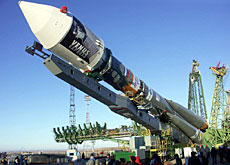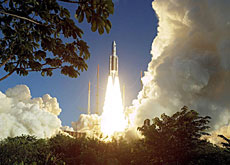Space probe makes lunar crash landing

Europe's first moon probe, equipped with Swiss technology, has signed off its three-year mission by crashing as planned into the moon.
Smart-1, a washing machine-sized cube, tested new space technology including a Swiss camera, which gathered information on the moon’s composition.
A small flash illuminated the lunar surface on Sunday as the European Space Agency’s (ESA) unmanned spacecraft crashed into the near side of the moon in the “Lake of Excellence” region at about 7,200 km/h.
“The measurements by Smart-1 call into question the theories concerning the moon’s violent origin and evolution,” ESA said on its website. “The moon may have formed from the impact of a Mars-sized asteroid with the Earth 4.5 billion years ago.”
The miniaturised imaging camera and an X-ray telescope were able to map large and small impact craters and study the volcanic and tectonic processes that shaped the moon. Smart-1 also carried an infrared spectrometer to seek out minerals.
Scientists will now begin analysing the mass of data acquired by the spacecraft.
If the moon was formed from the debris of an asteroid impact, it should contain less iron than the Earth in proportion to lighter elements such as magnesium and aluminium.
The images from the camera developed by the Neuchâtel company, Space-X, as well as the telescope and infrared detection will allow scientists to draw up new three-dimensional models of its surface.
These will provide clues about its chemical composition and origins.
Solar power
Another key reason for the mission was to test a new solar electric propulsion system, which is more efficient than traditional rocket technology for long-distance space journeys.
Zurich-based Contraves Space was involved in the construction of the system, which converts sunlight into electricity via solar panels and uses it to electrically charge heavy gas atoms.
The resulting beam of charged particles accelerates away from the spacecraft at high speed and drives it forward.
The speed at which the gas is ejected makes this technique much more efficient than traditional chemical rockets where the burning fuel creates gases which are expelled relatively slowly.
The technology has only been used once before on an interplanetary mission by the US space agency, Nasa.
Another Swiss firm, APCO Technologies in Vevey, designed and built the spacecraft’s aluminium shell, weighing just 42 kilograms.
swissinfo with agencies
The European Space Agency was formally established on May 31, 1975.
Its job is to draw up and implement a European space programme.
It has 16 member states: Austria, Belgium, Britain, Denmark, Finland, France, Germany, Greece, Ireland, Italy, the Netherlands, Norway, Portugal, Spain, Sweden and Switzerland.
The ESA has a staff of just over 1,900.
APCO Technologies is responsible for the concept, the development and manufacture of the Smart-1 shell.
Contraves developed the navigation system for the spacecraft’s propulsion.
ETEL Motion Technology delivered the engines which steered the navigation of the propulsion system.
The Space-X provided the miniature camera which was manufactured by the firm, Microcamera SA.

In compliance with the JTI standards
More: SWI swissinfo.ch certified by the Journalism Trust Initiative











You can find an overview of ongoing debates with our journalists here . Please join us!
If you want to start a conversation about a topic raised in this article or want to report factual errors, email us at english@swissinfo.ch.